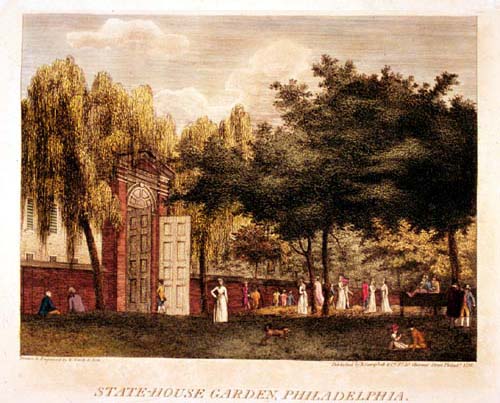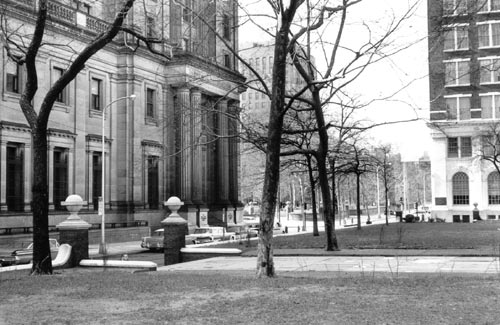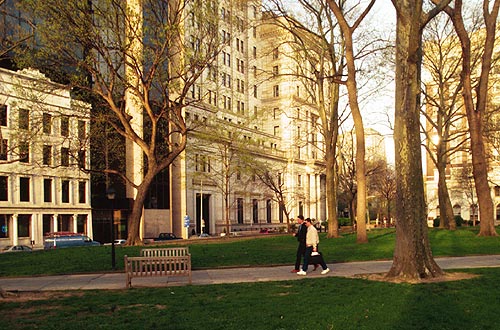By 1769, all the land now called Independence Square had been acquired by the Province of Pennsylvania. During the following year the garden was enclosed by a wall seven feet high, pierced at the center of the Walnut Street side by the tall arched gateway with solid wooden doors as shown in the engraving. Instigated by the American Philosophical Society, an astronomical observance of the transit of Venus across the sun was made from the square on June 3, 1769. Also, from a platform in the square, the Declaration of Independence was read publicly for the first time on July 8, 1776 by Colonel John Nixon. Landscaping in the garden in the "naturalistic style" was begun about 1784 under the direction of Samuel Vaughan, a Jamaican planter, member of the American Philosophical Society and temporary resident in Philadelphia who aroused considerable public interest in the square.
Photographs
Basic landscaping in the Independence Square garden has not changed since 1960, including the brick retaining walls, installed in the early 20th century, along Fifth, Walnut and Sixth Street. A full length statue (not shown) of John Barry, the renowned Philadelphia naval hero of the Revolution, remains the centerpiece of the garden. The 2000 photograph gives a wider perspective to particularly show the Penn Mutual Life Insurance Tower (now Penn Mutual Towers, BG-L) designed by Mitchell / Giurgola, completed in 1972. It incorporates, in its original place, the Egyptian revival facade of the Pennsylvania Fire Insurance Company's building, erected in 1938 from designs of John Haviland, and enlarged in 1902 from designs of T. P. Chandler. Other buildings facing the garden are (L to R) the Penn Mutual Life Insurance Company's first addition, designed by Ernest Mathewson, completed in 1932; the original Penn Mutual building at Sixth and Walnut Streets, designed by Edgar V. Seeler, completed in 1914; and facing Sixth Street, the Curtis Publishing Company's building (now Curtis Center) designed by Edgar V. Seeler, completed in Home Journal, Jack and Jill, Holiday, American Home and Country Gentlemen. Founder and publisher, Cyrus Curtis, also owned the Public Ledger, a newspaper which was housed in a companion building just to the north on Sixth Street (not shown, see commentary, Plate 14). Both buildings have been described as "colonial skyscrapers." In the distance (BG-C) is Washington Square, one of the five squares Penn set aside for public use. During the 18th and early 19th centuries the square was used as a Potter's Field (a burial ground for indigents.) The British buried their dead colonial prisoners of war there.
Back Next




